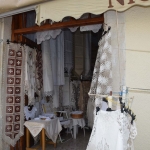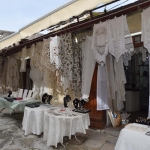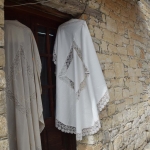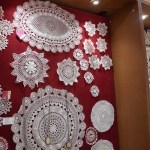Arkatena
The “arkatena koulourka” (crunchy rolls), which are known throughout Cyprus, were first made in Omodos around 1880. The art of “Arkatis” (singular, spiced extract from chickpeas used as yeast ), which is the secret of making this rusk, came to Omodos from Smyrna (today’s Izmir) through a female inhabitant of Smyrna, Hadjistasou, that -after coming to Cyprus -got acquainted with a local man, Hadjinikolis, got married to him and together they settled in Omodos. So, she taught the village’s other women hot to make the “arkatena”.
Ground chick-peas and ginger are used for the making of the “arkatis”. During the night they constantly stir it and this is the secret for a successful “arkateno” (singular of “arkatena”). In case it is not successful, then the rolls / rusks become stony, do not rise, and do not become light and crisp. The ingredients used for the making of the rolls are “arkatis” (see above), flour, and various aromatic essences such as mastic (gum), “mehlepi” (mahaleb cherry seeds), nutmeg, rose water, et al. The “piroma”, meaning the preparation of the oven, takes place along the making of the rolls. After being baked in the oven, they remain in their for several hours so that they harden. That means that one can have soft and hard rolls. Another item done is the “panisida” (large sesame loaf) that is offered in the church, in celebrations, and in memorials. Another kind of “arkateno” is the “mizana” (crescent-shaped roll), which is oblong and made out of 5-7 pieces, the “paksimadia” (plural of rusk), and it can also be made soft or hard.
In the old days the rolls and rusks were offered during visits, baptisms, and in weddings instead of the sweet or the Turkish delight that are offered today. Many times they are offered along with Chaloumi (Cyprus’s hard cheese) or meat.
Today, the ones celebrating still take “panisides” as a gift to the church, while rolls and rusks are usually used for breakfast. The housewives of Omodos make the rolls 4-5 times a year for the needs of the family. They are also made by some of the inhabitants for commercial purposes.
Editing of text: Panayiotis Socratous
Secretary of ecclesiastical committee
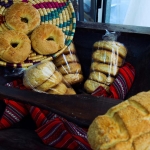
Omodos Wine
In the old days, the eminent and coveted wines, had to be produced by the viticulturists and the viticulturist then had to sell it by himself. It is for this the reason that each house had also its own deposit with a lot of big vats or later reservoirs where also today becomes the treatment of all grapes that are not sold to the wine industry or in local wine factories. The right manufacture of traditional wine was acquaintance from the ancient years at Omodos. This is also testified by the medieval “Linos” that is rescued.
The treatment of grapes had been said to be very important for the old season technology. In the old days each house had its own laboratory of production of wine.
Today only few home wine manufacturers have remained because most of them deliver all their grapes in the local wine factories and the big factories.
However in order to produce so much fragrant and tasteful wines it needs to follow a sequence of advisable works, from which some are done in our days.
The mature grapes, afterwards their collection, they are transported immediately in the mills for further treatment. In the old days they stepped on the grapes at special places, but later on they used mechanical mills. The quantity that will be placed in the mills is proportional to their volume.
Afterwards, juice and bagasse are placed in the containers of fermentation, in the old days at the vats, today in galvanized tanks for fermentation. At the duration of fermentation the bagasse are always kept sunk in the vats because if they come at the surface and they remain there for some time exposed to air there is danger of being polluted and furthermore to become vinegar.
The duration of fermentation oscillates between 15 – 25 days, depending on their content in sugar etc
After fermentation finishes, then the wine is ready for storage keep and it is transferred in clear vats, wooden barrels or galvanized which close airtightly in order to avoid the evaporation.
The four local wine factories that are equipped with latest technology instruments and tanks produce today most wines at Omodos for fermentation made by stainless steel.
The viticulturist from Omodos feels big joy and pride when it is in place to invite the foreigners in his house and serve them with wine, which was manufactured by himself.
Editing of text: Panayiotis Socratous
Secretary of ecclesiastical committee
Grape Products
Omodos, being a large wine-making village, has developed a great variety of products made out of grapes. The onset of making these products is lost in time. Today the products that are made out of grapes are an integral part of every Cypriot’s dishes. We display some of these products below:
EPSIMAN
(Must molasses)
After grinding the grapes, mainly dark-coloured ones, the must is separated from the grape husks and is placed in a “chardjin” (large caldron) to boil.
When the must starts to boil, all the impurities that might exist are removed, usually with the use of a skimmer. Then they remove it from the fire and allow it to cool down, throwing into it, bit-by-bit, some thin, white soil. As soon as the soil is added, foam is formed and it must be removed from the caldron. Adding the white soil cleans and sweetens the must. When it is thoroughly skimmed, it is left to cool down completely and it is placed in other vessels two or three times. The “pokathouliasi” (the product left at the bottom of the pot) is thrown away. The must is once again placed in the caldron and it is left to absorb all the juices and thicken without them stirring it. It must simmer down real well, otherwise it will go sour. Finally it becomes as thick as honey and has a black colour, with a sweet and sour taste.
It is kept in glass-made jars and used in many kinds of dishes.
PORTOS
(Pulp with boiled must and wheat)
After the “epsima” simmers down -and only when it starts to boil -wheat that has been washed is thrown in it. It is left to cook thoroughly without being stirred.
It is kept in large bottles used for sweets / deserts and it can be preserved for up to two years if it was simmered down properly.
Some women through roasted sesame in the “portos” after is has been made and taken off the fire.
PALOUZES
(Must jelly)
The same procedure followed for the making of “epsima” is used for the making of “Palouze”, up until the point when the must is transfused so that the impurities will be removed.
Before the must is placed on the fire, they add a proportional quantity of flour (about one kilo for every eight kilos of must). The caldron is placed on the fire and with a special scraper it is constantly stirred so as not to stick and form clots. When it starts to set, the women continue to stir it, adding rose water, cinnamon, and mastic.
The stirring continues until it is well cooked and it thickens. When the mixture does not stick on one’s hand or the spoon it is an indication that it is well cooked.
It is usually eaten with almond or walnut nuts and it can be preserve only for a few days. In Omodos the “palouze”, as well as the other dishes made out of grapes, are produced near the end of the harvest.
KIOFTERKA
(Dry must jelly in rhomboid shape)
They are pieces -cut in the shape of baklava -out of aforementioned “palouze”, which are placed in the sun to dry for many days. In this way they become the delicious “kiofterka” that are usually eaten during the winter.
SOUTZIOUKOS
(Must-stick with almonds)
The celebrated “soutzioukos” made in Omodos is also quite well known. The reason for this is that it is always made out of good quality, aromatic grapes.
When the “palouze” starts to set, then the fire is lowered and the so-called “dipping” of the stick begins. The stick is nothing other than a thread, about two meters long, running through almond nuts or walnuts and having its two ends tied to a forked piece of wood.
As soon as the women dip the “stick”, they pull it out it and dip it in once more, hang it up to dry for a few minutes and continue dipping other threads. When the first one is dry they dip it in again 2-3 times.
The next day they make another mixture and dip each stick in it 3-4 times like before. They create 4 mixtures in total during 4 different days, thus making a number of coatings in the “sioutziouko”. When the process is complete they leave it hanging in the air for about twenty days until it becomes dry.
Most of the “soutzioukos” that is made in Omodos is used for domestic purposes and only some of it is used for commercial purposes.
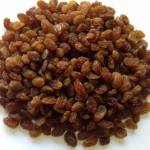
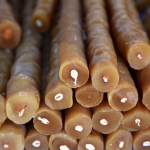

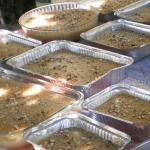

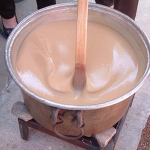
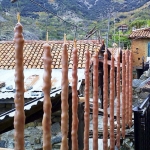
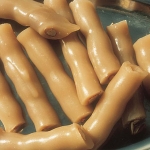
Omodos Narrow-Knit Lace
The countryside of Cyprus is famous for the preservation of the traditional way of living and of its manners and customs, as well as for the hospitality of its inhabitants. Every village has its own characteristics. Omodos is not only a village reputable for its wine-making and its “arkatena” rusks, it is also known for its laces -the celebrated “pipiles” (plural, Narrow-Knit Laces).
The woman of Omodos plays a leading role in life’s everyday labours. Thanks to her, domestic handicraft was -and still is -flourishing in Omodos.
Since ancient times, the narrow-knit lacing possessed a special place amongst the renowned embroideries of Omodos’s women. A Centre for the Preservation of (Narrow-Knit) Lacing -perhaps the first one in Cyprus -was established so as to salvage it.
The history of Narrow-Knit Lacing
The handmade, thin lace done by needles is a beautiful and famous embroidery from Omodos and ranks first amongst Omodos’s handwork items. According to living testimonies, it is believed that their origin is Byzantine. Besides, both its Technique as well as the designs present important similarities with the Technique, the motifs, and the raw material for the construction of the Lace that was developed in Constantinople, Smyrna (today’s Izmir), and in the island of the Eastern Aegean.
Moreover, the bonds between the Monastery of the Holy Cross and the Metropolis of Christendom and Orthodoxy, Byzantium, were known since old times. In the suburbs of Constantinople there was a “metochi” (monastery dependency / estate) in which the overseer was a representative of the Prior of Omodos’s Monastery.
Laces similar with those in Omodos are also detected in other parts of Cyprus, in cities and in the countryside. Also, in the islands of Crete, Rhodes, Ko, Psara, Samos, Skyros, in Constantinople and in Smyrna. Their sample can be found today in the Museum of Folkloric Art in Cyprus and Abroad, many of them being presented in studies and in books.
This kind of lace pertains to the “Knot with the needle” or “one Knot close to the other” technique. The “velonokompos” (kind of stitch) or double “velonokompos” is used for the creation of the designs.
The fabrication technique is similar to that of the “kefalaio” (Capital) that is observed in the eastern Mediterranean around the 5 th century BC. The simple knots also resemble the age-long technique of making fishing nets.
Written information mention Byzantium as a Centre of developing this type of Lace.
Besides, the customary attires of both the chanters and also the emperors in Byzantium with their -inlaid with gold -laces were also renowned.
According to written testimonies, one can detect that Cyprus was a production Centre of laces and threads that were inlaid with gold in that same era, making exports to the Byzantine area.
Name and use of “pipila”
The name for narrow-knit lacing (pipila) comes from the Turkish word “bir-bir” (,”birbila”, “pipila”), which means “one after the other in succession”. It is a kind of thin lace and is made with a needle and white thread or “avana”, always combined with the imagination and craftsmanship of each woman so as to make uniquely beautiful designs.
For the creation of the various designs, the women use the “velonokompos” or double “velonokompos” as the basic knot. Some designs (“kollisis”, plural, meaning adhered, attached items) are the Venetian, the “Athasoudi” (little almond), the “tourkou” (Turkish female), the “mougia” (fly), the “fyseroti” (fan-like), the “trikompoudi” (three small knots), the “mouti” (nose, edge), the “satetiko” (simple, single design), the “kyparissoudi” (small cypress tree), the “kamaroues” (arches, apses), et al. The women of Omodos make various sizes, small or large, simple or complex narrow-knit laces, giving them different geometrical shapes, starting from round and varying to square, rectangular, even oval or any other kind of shape they can imagine, depending on the object they want to decorate. The narrow-knit lace was used -and is still used today -for decorating their furniture and beds with the “pitsilia” and the “tornaretous” (plural, pleated fabrics / valances).
The narrow-knit lace was also an essential decorative item in the “stambota” (plural, meaning stamped) bandannas / headbands. The narrow-knit lacing was used to decorate costumes, shirts, and other items of clothing.
Editing of text: Panayiotis Socratous
Secretary of ecclesiastical committee
